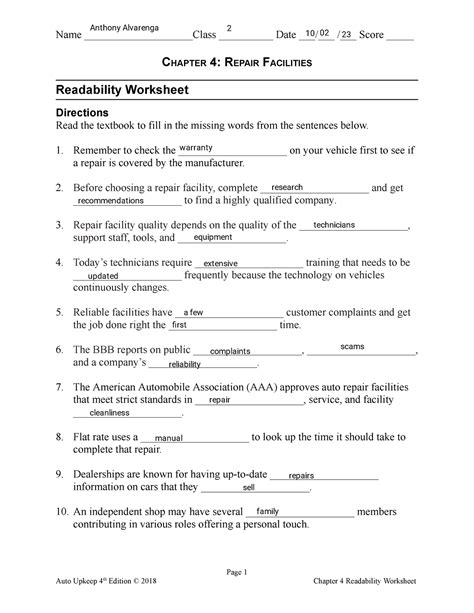Understanding Readability for Effective Communication
Introduction

Readability is a crucial aspect of written communication that ensures your message is conveyed clearly and effectively. Understanding readability levels helps writers tailor their content to the intended audience. This article provides comprehensive answers to the Chapter 6 Readability Answers: Autoupkeep Academy Worksheet, guiding you through the intricacies of readability and its impact on communication.
What is Readability?
Readability refers to the ease with which a text can be read and understood. It is determined by several factors, including sentence length, word choice, and text structure. A highly readable text is effortlessly comprehensible, while a low readability text presents challenges to the reader.
Pain Points
Low readability can result in:
- Reduced comprehension
- Increased confusion and frustration
- Loss of engagement
- Negative impact on credibility
Motivations
Improving readability matters because it:
- Enhances communication effectiveness
- Builds credibility and trust
- Increases audience engagement
- Facilitates knowledge transfer
Measuring Readability
Various readability formulas are used to assess the complexity of written content. Two widely used formulas are the Flesch Reading Ease Score and the Flesch-Kincaid Grade Level.
Table 1: Readability Formulas
| Formula | Calculation | Result |
|---|---|---|
| Flesch Reading Ease Score | 206.835 – 1.015 * (number of words / number of sentences) – 84.6 * (number of syllables / number of words) | 0-100 scale, higher scores indicate easier readability |
| Flesch-Kincaid Grade Level | 0.39 * (number of words / number of sentences) + 11.8 * (number of syllables / number of words) – 15.59 | Grade level equivalency, lower scores indicate easier readability |
Factors Affecting Readability
Several factors influence readability levels:
- Sentence Length: Short sentences are easier to process.
- Word Choice: Familiar and simple words enhance readability.
- Text Structure: Clear organization and logical flow improve understanding.
- Active Voice: Using active voice enhances clarity and engagement.
- White Space: Ample white space improves readability by reducing visual clutter.
Chapter 6 Readability Answers: Worksheet Questions
Question 1: What is the purpose of readability in communication?
Answer: Readability ensures that messages are easily understood and effectively conveyed.
Question 2: What are the key factors that affect readability?
Answer: Sentence length, word choice, text structure, active voice usage, and white space utilization.
Question 3: What is the optimal Flesch Reading Ease Score for effective communication?
Answer: A score above 70 is considered highly readable and appropriate for most audiences.
Question 4: What are the negative consequences of low readability?
Answer: Reduced comprehension, increased confusion, loss of engagement, and diminished credibility.
Innovative Applications of Readability
Pain Points:
Traditional readability formulas often fail to account for:
- Text complexity
- Reader knowledge level
- Cultural and linguistic differences
Motivations:
To address these challenges, researchers are developing innovative readability assessment methods:
- Natural Language Processing (NLP): Analyzes text using artificial intelligence to identify readability patterns and predict comprehension levels.
- Cognitive Modeling: Simulates human cognitive processes to assess the cognitive load and readability of text.
- Eye-Tracking Studies: Monitors eye movements to understand how readers interact with text and identify potential readability barriers.
Useful Tables for Readability Analysis
Table 2: Readability Levels and Audiences
| Readability Level | Flesch Reading Ease Score | Flesch-Kincaid Grade Level | Target Audience |
|---|---|---|---|
| Very Easy | 90-100 | 0-3 | Children, ESL learners |
| Easy | 80-90 | 4-6 | General audiences, high school students |
| Fairly Easy | 70-80 | 7-9 | College undergraduates, business professionals |
| Standard | 60-70 | 10-12 | Graduate students, researchers |
| Fairly Hard | 50-60 | 13-15 | Technical professionals, academic writing |
| Hard | 0-50 | 16+ | Specialized audiences, research papers |
Table 3: Readability Assessment Tools
| Tool | Website |
|---|---|
| Hemmingway Editor | https://hemingwayapp.com/ |
| Readability Analyzer | https://readabilityformulas.com/ |
| WebFX Readability Test | https://www.webfx.com/tools/read-able/ |
Table 4: Tips for Improving Readability
| Tip | Description |
|---|---|
| Use short sentences (15-20 words) | Enhances clarity and comprehension. |
| Choose familiar and simple words | Avoid jargon and technical terms. |
| Use active voice | Makes sentences more direct and engaging. |
| Provide clear text structure | Use headings, subheadings, and bullet points to organize information. |
| Use white space effectively | Adequate white space improves visual appeal and readability. |
FAQs on Readability
1. Why is readability important in technical writing?
Readability ensures that complex technical concepts are conveyed clearly and effectively to non-technical audiences.
2. What is the target readability level for website content?
Aim for a Flesch Reading Ease Score of above 70 for easy readability and accessibility to a broad audience.
3. How does white space affect readability?
White space helps break up text, improve visual appeal, and reduce cognitive load.
4. What are the limitations of readability formulas?
Readability formulas do not fully capture the complexities of human comprehension and cultural differences.
5. How can I improve the readability of my writing?
Use short sentences, simple words, active voice, clear text structure, and ample white space.
6. What are the benefits of using a readability assessment tool?
Readability assessment tools provide objective feedback on text complexity and suggest improvements to enhance readability.
7. How does audience knowledge affect readability levels?
The readability level should be appropriate for the target audience’s knowledge and comprehension level.
8. What is the role of cultural context in readability?
Cultural differences can influence the familiarity of words and concepts, impacting readability levels.
Conclusion
Understanding readability is essential for effective communication. The answers provided in this article for the Chapter 6 Readability Answers: Autoupkeep Academy Worksheet offer a comprehensive guide to readability concepts and practical applications. By incorporating these principles into your writing, you can create highly readable content that engages your audience, conveys your message clearly, and achieves your communication goals.
